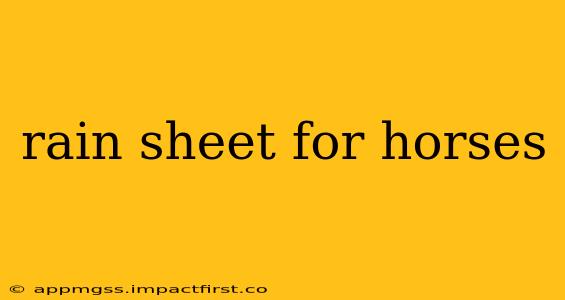Keeping your horse dry and comfortable, especially during inclement weather, is crucial for their well-being. A high-quality rain sheet provides essential protection against the elements, preventing chills, discomfort, and potential health problems. This comprehensive guide delves into the world of horse rain sheets, helping you choose the perfect one for your equine companion.
What is a Horse Rain Sheet?
A horse rain sheet is a lightweight, waterproof outer layer designed to protect your horse from rain, wind, and light snow. Unlike heavier turnout blankets, rain sheets are primarily focused on water resistance and breathability, allowing for air circulation to prevent overheating and sweating. They're typically used during milder weather conditions when full turnout blankets are unnecessary.
What are the Different Types of Horse Rain Sheets?
The market offers a variety of rain sheets, each catering to specific needs and preferences. Understanding these differences is key to making an informed purchase.
By Material:
- Nylon: A popular choice due to its durability, water resistance, and affordability. Nylon rain sheets are generally lightweight and easy to clean.
- Polyester: Often blended with other materials, polyester offers good water resistance and breathability. It's often a more budget-friendly option than nylon.
- Ripstop: This fabric features reinforced threads to prevent tears and increase durability, making it ideal for active horses.
- Canvas: A heavier-duty option, canvas rain sheets offer superior protection against harsh weather but may be less breathable.
By Features:
- Standard Rain Sheets: These offer basic protection from rain and wind.
- Lightweight Rain Sheets: Ideal for milder weather, these provide water resistance without being overly bulky.
- Fly Sheets with Rain Resistance: Offering dual protection, these sheets deter flies while providing some rain protection (although typically not as waterproof as dedicated rain sheets).
- Combo Sheets: Some rain sheets offer features like neck covers, leg straps, or tail flaps for added protection.
What Features Should I Look For in a Horse Rain Sheet?
Choosing the right rain sheet involves considering several key features:
- Waterproofness: Look for a sheet with a high water resistance rating.
- Breathability: This prevents sweating and overheating.
- Durability: Consider the fabric and stitching quality to ensure longevity.
- Fit: A properly fitting sheet is crucial for comfort and effectiveness. It shouldn't be too tight or too loose.
- Closure System: Strong and secure closures (e.g., chest straps, surcingles, leg straps) prevent the sheet from slipping or coming undone.
- Tail Flap: A tail flap provides extra protection from rain and dirt.
- Neck Cover: A detachable neck cover offers additional protection from the elements.
How Do I Measure My Horse for a Rain Sheet?
Accurately measuring your horse is crucial to ensure a proper fit. Measure your horse's back length from the center of the withers to the base of the tail. Consult the size chart provided by the manufacturer for precise sizing. Many companies provide detailed instructions and videos on their websites to guide you through this process.
How Often Should I Clean My Horse's Rain Sheet?
Regular cleaning maintains the sheet’s effectiveness and prolongs its lifespan. Depending on usage, wash the sheet after every few uses with a mild detergent specifically designed for horse blankets. Air drying is recommended to prevent damage.
What is the Difference Between a Rain Sheet and a Turnout Blanket?
While both offer protection, their primary purposes differ. Rain sheets are designed primarily for water resistance in milder conditions, prioritizing breathability. Turnout blankets provide more robust protection against harsh weather, including heavier rain, snow, and wind. They are often thicker, more durable, and offer greater insulation.
How Do I Choose the Right Rain Sheet for My Horse?
Consider your horse's individual needs, the climate you live in, and your budget. A lightweight rain sheet might suffice for milder conditions, while a heavier-duty sheet is necessary for harsher weather. Assess your horse's activity level to determine the level of durability required.
By carefully considering these factors, you can select a rain sheet that keeps your horse dry, comfortable, and healthy throughout the year. Remember to always prioritize a proper fit for optimal performance and to check regularly for any damage or wear.
